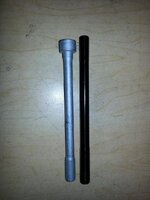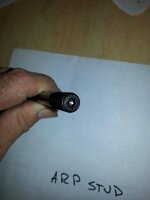K
KMS
Well-known member
TURBO TALK – HEAD STUDS
This is a weekly discussion on "grey" areas in regards to turbocharging. I answer many of the same questions everyday...one at a time on many confusing subjects that really are misunderstood. I want to help, so, we will open up 1 new topic per week to provide accurate information and explain how and why stuff works. This weeks topic is head studs.
When you turbocharge any engine, peak combustion pressures can rise to 2200 psi. The factory head hardware from most manufactures was only designed for 1500-1700 psi. This additional stress causes the oe bolt to momentarily flex or stretch. This flexing is never detectable until the head gasket fails. What happens is as you are increasing rpm and the average combustion pressure increases, the head actually lifts. This reduces the clamping force on the head gasket, pressures over come the head gasket material structure, and then head gasket failure...
What is the fix? Better Hardware! The use of studs is a start. Studs provide more potential clamping force than bolts. Second is the style of stud used. Most OE head bolts use a reduced center section that allows the bolt to stretch or yield during the torquing process.

Not a bad idea because it can self align and achieve high torque values with small thread pitch diameters....however the down side is that when the pressures exceed intended design, they continue to yield or stretch. This again leading back to a blown head gasket. So, when choosing the right stud for the job, you want to use one that has little or no center reduction. That way once the stud is torqued, it will stretch no further and locking the head gasket down under extremely high pressures.
So what your saying is: If I turbo my bike, I have to replace the head gasket and install studs, right? No. If you choose a stud that has a broached end (an end that accepts a driver like allen or socket), you can remove one head bolt at a time and install one head stud at a time....saving you time and money. The name of the game is that the head gasket never moves from its original compressed form and location.

Thanks
Kelly
This is a weekly discussion on "grey" areas in regards to turbocharging. I answer many of the same questions everyday...one at a time on many confusing subjects that really are misunderstood. I want to help, so, we will open up 1 new topic per week to provide accurate information and explain how and why stuff works. This weeks topic is head studs.
When you turbocharge any engine, peak combustion pressures can rise to 2200 psi. The factory head hardware from most manufactures was only designed for 1500-1700 psi. This additional stress causes the oe bolt to momentarily flex or stretch. This flexing is never detectable until the head gasket fails. What happens is as you are increasing rpm and the average combustion pressure increases, the head actually lifts. This reduces the clamping force on the head gasket, pressures over come the head gasket material structure, and then head gasket failure...
What is the fix? Better Hardware! The use of studs is a start. Studs provide more potential clamping force than bolts. Second is the style of stud used. Most OE head bolts use a reduced center section that allows the bolt to stretch or yield during the torquing process.

Not a bad idea because it can self align and achieve high torque values with small thread pitch diameters....however the down side is that when the pressures exceed intended design, they continue to yield or stretch. This again leading back to a blown head gasket. So, when choosing the right stud for the job, you want to use one that has little or no center reduction. That way once the stud is torqued, it will stretch no further and locking the head gasket down under extremely high pressures.
So what your saying is: If I turbo my bike, I have to replace the head gasket and install studs, right? No. If you choose a stud that has a broached end (an end that accepts a driver like allen or socket), you can remove one head bolt at a time and install one head stud at a time....saving you time and money. The name of the game is that the head gasket never moves from its original compressed form and location.

Thanks
Kelly

